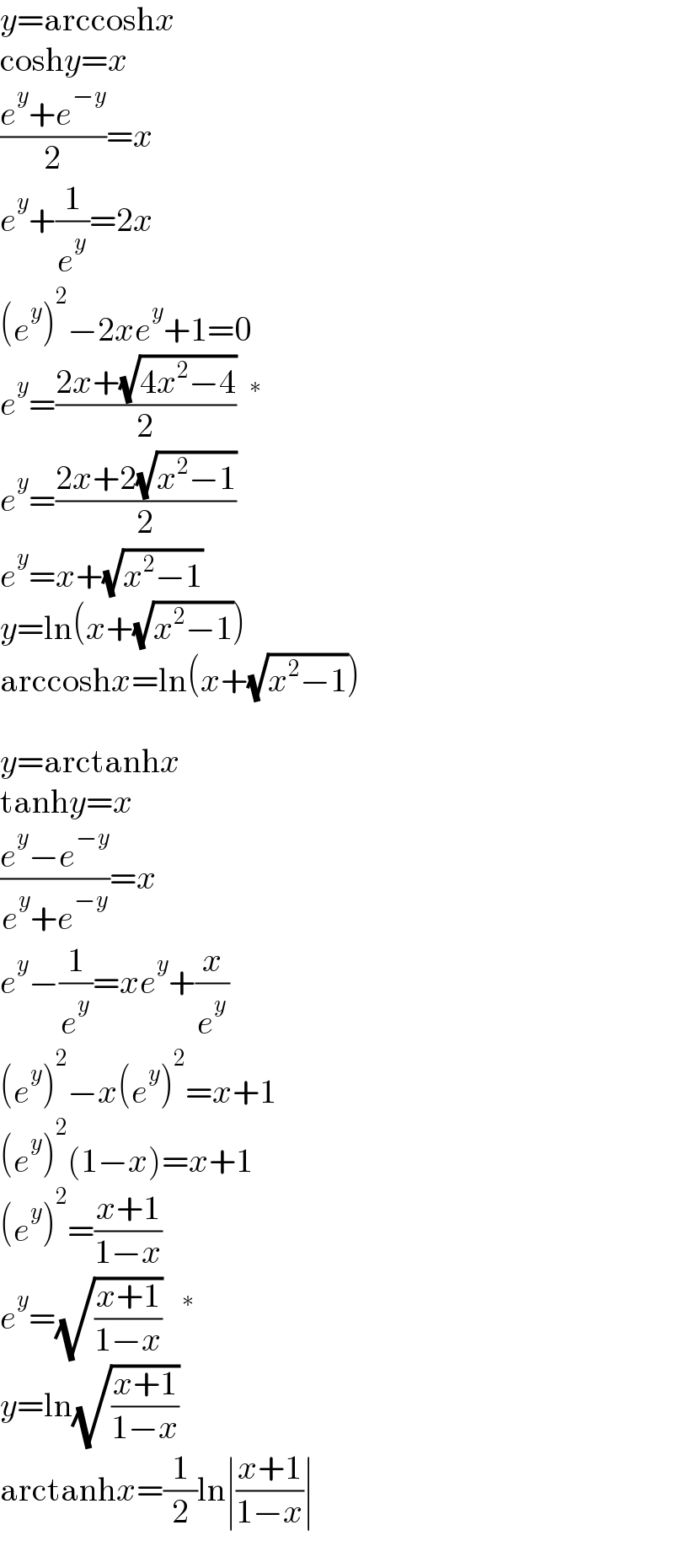
Question Number 178577 by Spillover last updated on 18/Oct/22

$$\mathrm{prove}\:\mathrm{that} \\ $$ $$\left(\mathrm{a}\right)\mathrm{cosh}\:^{−\mathrm{1}} \mathrm{x}=\pm\mathrm{ln}\:\left(\mathrm{x}+\sqrt{\mathrm{x}^{\mathrm{2}} −\mathrm{1}}\right) \\ $$ $$\left(\mathrm{b}\right)\mathrm{tanh}\:^{−\mathrm{1}} \mathrm{x}=\frac{\mathrm{1}}{\mathrm{2}}\mathrm{ln}\:\left(\frac{\mathrm{x}+\mathrm{1}}{\mathrm{x}−\mathrm{1}}\right),\mid\mathrm{x}\mid<\mathrm{1} \\ $$
Answered by depressiveshrek last updated on 18/Oct/22

$${y}=\mathrm{arccosh}{x} \\ $$ $$\mathrm{cosh}{y}={x} \\ $$ $$\frac{{e}^{{y}} +{e}^{−{y}} }{\mathrm{2}}={x} \\ $$ $${e}^{{y}} +\frac{\mathrm{1}}{{e}^{{y}} }=\mathrm{2}{x} \\ $$ $$\left({e}^{{y}} \right)^{\mathrm{2}} −\mathrm{2}{xe}^{{y}} +\mathrm{1}=\mathrm{0} \\ $$ $${e}^{{y}} =\frac{\mathrm{2}{x}+\sqrt{\mathrm{4}{x}^{\mathrm{2}} −\mathrm{4}}}{\mathrm{2}}\:\:^{\ast} \\ $$ $${e}^{{y}} =\frac{\mathrm{2}{x}+\mathrm{2}\sqrt{{x}^{\mathrm{2}} −\mathrm{1}}}{\mathrm{2}} \\ $$ $${e}^{{y}} ={x}+\sqrt{{x}^{\mathrm{2}} −\mathrm{1}} \\ $$ $${y}=\mathrm{ln}\left({x}+\sqrt{{x}^{\mathrm{2}} −\mathrm{1}}\right) \\ $$ $$\mathrm{arccosh}{x}=\mathrm{ln}\left({x}+\sqrt{{x}^{\mathrm{2}} −\mathrm{1}}\right) \\ $$ $$\: \\ $$ $${y}=\mathrm{arctanh}{x} \\ $$ $$\mathrm{tanh}{y}={x} \\ $$ $$\frac{{e}^{{y}} −{e}^{−{y}} }{{e}^{{y}} +{e}^{−{y}} }={x} \\ $$ $${e}^{{y}} −\frac{\mathrm{1}}{{e}^{{y}} }={xe}^{{y}} +\frac{{x}}{{e}^{{y}} } \\ $$ $$\left({e}^{{y}} \right)^{\mathrm{2}} −{x}\left({e}^{{y}} \right)^{\mathrm{2}} ={x}+\mathrm{1} \\ $$ $$\left({e}^{{y}} \right)^{\mathrm{2}} \left(\mathrm{1}−{x}\right)={x}+\mathrm{1} \\ $$ $$\left({e}^{{y}} \right)^{\mathrm{2}} =\frac{{x}+\mathrm{1}}{\mathrm{1}−{x}} \\ $$ $${e}^{{y}} =\sqrt{\frac{{x}+\mathrm{1}}{\mathrm{1}−{x}}}\:\:\:^{\ast} \\ $$ $${y}=\mathrm{ln}\sqrt{\frac{{x}+\mathrm{1}}{\mathrm{1}−{x}}} \\ $$ $$\mathrm{arctanh}{x}=\frac{\mathrm{1}}{\mathrm{2}}\mathrm{ln}\mid\frac{{x}+\mathrm{1}}{\mathrm{1}−{x}}\mid \\ $$
Commented bySpillover last updated on 18/Oct/22

$$\mathrm{thank}\:\mathrm{you} \\ $$
